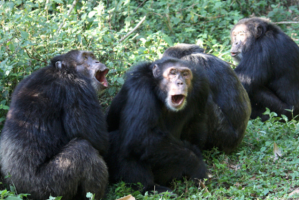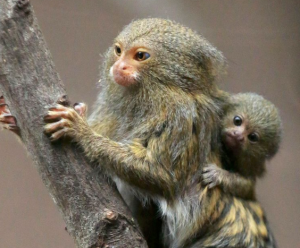[This post is a collaboration with John Jay College student Linda Armstrong, who is majoring in Comparative Human-Animal Behavior through the CUNY-BA program.]
The last few decades have seen an explosion of research revealing that animal species possess intricate forms of communication, including facial expressions, body language and gestures, and vocal calls. As in humans, animals utilize these abilities for survival purposes, such as communications about food resources, warning others of danger, and socializing, which is used for building communities and families.
For example, chimpanzees use gestures, touching, calls, and displays for their sophisticated communication. They also use something called the pant-hoot, which is a call for help or immediate attention. Incredibly, chimps have personal variations between each pant-hoot, which allows them to determine who is calling who.

Personal variation has also been observed in vervet monkeys. Vervet parents have the ability to discriminate different infants based on their cries. When an infant vervet cries, its mother looks in the direction of the scream. Not only is the crying acknowledged by the infant’s mother, but by other vervet parents as well, who look to the parent when an infant cries.
Vervets also utilize various calls for survival strategies against enemies that are present either at a specific distance, height or terrain. For example, if an eagle is stalking, it is best to seek shade cover or if you’re in a tree already, you’d better come down from the top. If a leopard is hunting, however, it is best to climb up the tree as high as possible. If a snake is close by, it’s best to get out of the tree altogether and look for a clearing where they can be easily spotted and avoided. Each predator that causes a threat to this species, will elicit a specific call from one of the members, so the rest of them know how to properly hide or escape that threat.

Prairie dogs are another example of sophisticated communication among animals. By varying the pace and pitch of their calls, prairie dogs can alert their comrades when a predator is approaching, how fast, the type of predator and the appropriate response for that predator. For instance, when she spots a hawk, a prairie dog sounds an alarm and the other dogs respond by immediately running to their burrow holes and diving deep down inside. Incredibly intelligent, prairie dogs aren’t just able to communicate the type of threat, but also some details about the predator and the threat level. For the prairie dog, an antelope is a sign of safety as the antelope and prairie dog share some of the same predators.
In sum, we find that across all animal species, there is a wide range of communicational cues. Some animals utilize communication as warning others, as we see with the prairie dogs, while others utilize it for building communities and families, as we have seen within the vervet community. Other animals, such as marmosets have varied calling patterns, some dependent on the situations and their locations.
In a new paper published by Yvonne Zurcher and Judith Barkart in the International Journal of Primatology, Evidence for Dialects in Three Captive Populations of Common Marmosets, these two researchers analyzed the acoustic properties of marmoset calls. The researchers wanted to know if different marmoset populations had calls with different acoustic properties. In other words, do different marmoset groups “speak” with a different “accent.” The goal of this is to gain insight into whether the calls are a part of a marmoset’s inborn genetic disposition or if their environment shapes how their communication is formed. They also wanted to compare/contrast the effects of the sounds made by adult marmosets and see how these sounds effected young marmoset’s vocal usage and production.

The researchers focused on three main social calls within the marmoset populations; phee calls, trill calls and food calls. Phee calls are long-distance contact calls usually made when animals are separated from each other, and also used in turn-taking sequences between animals. Trill calls are close-distance calls that are often emitted during foraging in the wild. And food calls are emitted when animals find and communicate about preferable food.
They recorded these calls from three different captive populations of common marmosets, consisting of 55 individuals from the Istituto Superiore di Sanita in Rome, the Universidad Autonoma de Madrid in Spain, and the Department of Anthropology, University Zurich in Switzerland.

During the recording procedures, researchers simulated the same conditions that the marmoset groups were housed in; so that it wouldn’t influence their readings. The only adjustment made was their pairing, as they were paired together or separately depending on the circumstance. For instance, the marmosets from Rome were alone, while the marmosets from Madrid were in pairs and the marmosets from Zurich had a combination of being in pairs or separated.
To elicit phee calls, the researchers separated individual subjects from the group with auditory, not visual contact. No intervention was needed to elicit trill calls. To get the food calls, the researchers provided individuals with a mixture of highly preferred foods, which varied between populations. During data analysis, the researchers had to control for body mass, since this is known to correlate with pitch in marmoset vocalizations. Once the calls were recorded and coded, the researchers analyzed them for differences among the different populations.
This research revealed that there were indeed different dialects across the marmoset communities. The acoustic structures of the calls were analyzed and then compared using two statistical tools called principal component analysis and permutated discriminant function analysis. This tool is an unbiased approach and looks for distinct features and patterns which can be used to classify the calls into groups. The analysis was able to accurately group the calls into the three regional origins more than 75% of the time, and in some trials up to 96% of the time. This means that the acoustic structures of the calls made by the marmosets in these three populations were distinct enough for a computer to separate them into the three groups (with some overlap, of course). Differences in body mass were not able to explain these differences.

What these results mean is that the structure and nature of calls in marmosets are fluid and vary among populations, not unlike regional accents in human speech. A resident of New York City and one of London can completely understand each other, even though every single word is pronounced a little bit differently. If these two cities were separated without communication between them for generations, their accents would further drift apart to become dialects. After many more generations, the dialects would sufficiently diverge to become different languages. What we have learned from this study is that marmosets are very much the same. Their language is malleable and changes over time.
The implication of this finding is that the speech abilities of marmosets share some of the same qualities as the speech abilities of humans. We have a biologically programmed drive to speak, to make verbal utterances with our throats and mouths. But what comes out of our throats and mouths is NOT biologically programmed. We are driven to make noises, but we learn to speak. The same is true for marmosets – children learn the calls by observing their elders.

Interestingly, two females in the Madrid group produced significantly different phee calls from those heard in the other colonies. (These were removed from the analysis to be sure they were not over-interpreted.) These distinct calls could be the beginning of a new word or a new accent. We presume that this different call is sensical to the other marmosets in Madrid, but it may not be to the other groups. It will be interesting to see if this new call takes is learned by others and perpetuated. (Remember the mandrill that invented a new gesture?)
As the authors admit, this study could not rule out founder effects (genetic drift) as an explanation for the different marmoset accents. This seems unlikely anyway.
An interesting follow-up study which would confirm these conclusions would be to switch young marmosets among the colonies. By doing this, we would be able to see what effects a young marmoset’s vocal learning abilities, genetics or environment. For example, if we switched infants from Zurich with those from Madrid, and observed their progress, we could see if the switched infants take on the language of their original community or their adopted one. This would immediately tell us if their language acquisition is genetic or social.
In conclusion, mounting evidence tell us that the language learning of other primates shows a lot of similarity to humans. We see through multiple examples that communication in others species vary by geography, much like it does in humans, despite accomplishing the same goals; such as building and maintaining communities, finding food, avoiding predators and so forth. It seems that animals learn language the same way the humans do: by listening to others.
-This post was written by Linda Armstrong and lightly edited by NHL.
